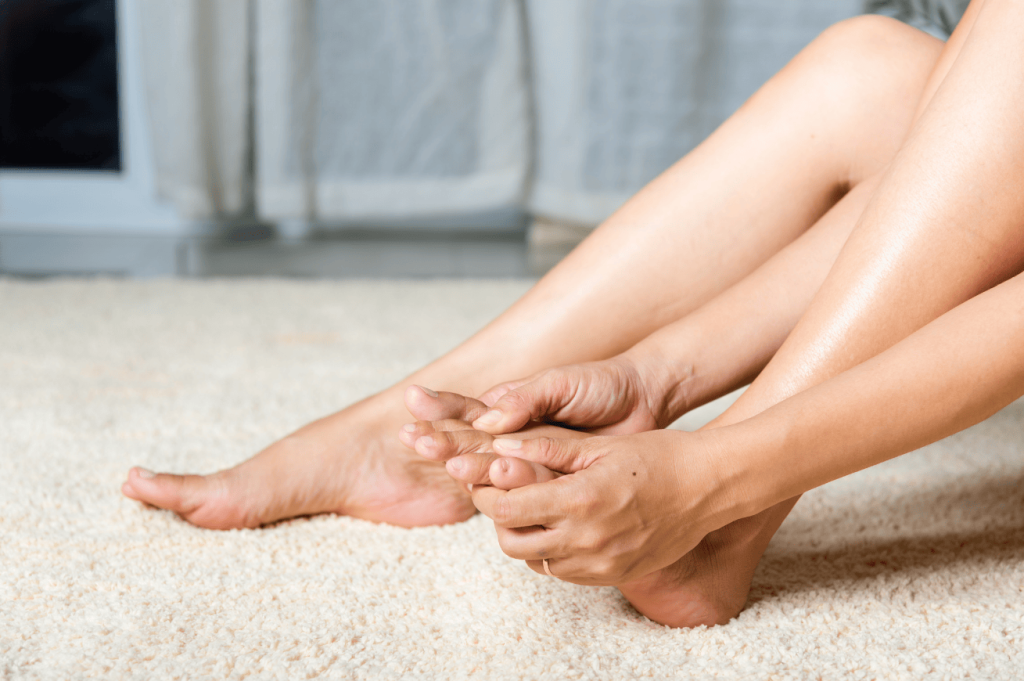Our feet and lower legs are often our first line of defence against the strains of the day. Whether commuting to work, jogging or hitting the squat rack at the gym, the frequent, repetitive stresses of daily life can contribute to developing a wide variety of common foot conditions & problems.
Mobile podiatrists can provide preventative advice or treatment for these conditions from the comfort of your own home, helping ensure that your feet can continue to carry you through your day.

What Are Common Foot Problems?
Whether caused by physical stress or another factor, some of the most common foot conditions a podiatrist may treat include:
- Athlete’s Foot: Athlete’s foot is a fungal infection that can affect the skin of the foot. Some symptoms include itchiness, burning and redness. It’s associated with warm, moist environments like locker rooms, which may be unhygienic.
- Blisters: Blisters are often a response to friction or irritation. The raised fluid-filled sacs can be painful.
- Corns and Calluses: Thickened areas of skin can form as a response to pressure or friction. Corns are typically the smaller round areas of thickened skin that form on or between the toes, while Calluses are the larger flat areas that commonly form on the soles of the feet.
- Heel & Arch Pain: Discomfort in the Heel & Arch of the foot can be caused by several conditions, such as Plantar Fasciitis or Achilles Tendinitis.
- Ingrown Nails: When a nail on the edge of your toe breaks through the skin, you have an ingrown nail. Ingrown nails can cause swelling, tenderness and infections where the area fills with pus.
- Plantar Fasciitis: A band of connective tissue runs from the heel to the ball at the bottom of the foot. Pain and/or tissue damage in this area is known as Plantar Fasciitis.
Foot and lower leg conditions can affect people from all walks of life. Most people will experience some form of foot or lower leg condition during their lifetime.
What Causes Foot Conditions
A wide range of factors can contribute to developing a foot condition, including lifestyle or environmental factors, genetics and more. Understanding these factors is often the first step in reducing the likelihood of developing these conditions. Several significant factors include:
- Choice of Footwear: Shoes that don’t fit properly, are too tight, too loose or lack support can promote the development of conditions such as bunions, calluses and ingrown toenails.
- Hygiene: Poor foot hygiene or walking barefoot in public locker rooms or showers can increase your risk of developing fungal infections like athlete’s foot.
- Repetitive Stress: Frequent and repetitive stress to the feet, such as through frequent running, can lead to stress-related foot conditions.
- Genetics: Some conditions can be hereditary, such as Hammer toe.
- Weight: Excess weight can increase the pressure placed on a person’s feet, lower legs and joints, which can contribute to developing conditions in the foot and ankle.
- Age: As people age, the fat pads under the balls of their feet and heels thin out, and the flexibility of their ligaments can decrease, contributing to an increased risk of some foot conditions.
- Medical Conditions: Other medical conditions may be closely tied to the development of related foot conditions, such as diabetes and the development of diabetic foot.
If you’re concerned that any of these factors are adversely affecting your foot or lower leg health, consider booking an appointment with a mobile podiatrist for professional advice.
Preventing Common Foot Conditions
Preventing foot or lower leg conditions doesn’t need to be difficult. Small changes to your routine or apparel can reduce your likelihood of developing many of these conditions.
To help prevent fungal infections, such as athlete’s foot or toenail functions, keep your feet clean and dry, and avoid walking barefoot in public areas or sharing towels, socks or shoes with others. You may also benefit from an investment in moisture-wicking socks.
For pressure or strain-related conditions, ensure you have well-fitting, supportive shoes and stretch regularly. If these conditions are a frequent concern, consider consulting a podiatrist about orthotic insoles for additional arch support.
For thick, hardened skin conditions like corn and calluses, use moisturiser regularly to keep the skin soft, or if more advanced, soak your feet in warm, soapy water to soften the skin and then exfoliate with a foot file or pumice stone.
For more comprehensive care, consider booking an appointment with a mobile podiatrist for more specific advice that better accounts for your lifestyle factors and individual foot health needs.
The mobile podiatrists at Grace Podiatry are your local Perth podiatrists. We can help assess, identify and assist in the treatment and prevention of common foot problems like those mentioned above, all from the comfort of your own home. Whether you are concerned about one of the common foot conditions above or another issue, contact us today for all of your podiatric needs.








